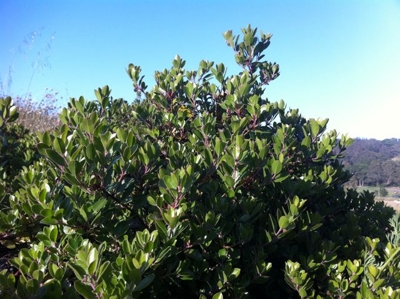Delay, Duplicity Lead to Lawsuit to Protect San Francisco’s Miracle Manzanita
June 14, 2011
FOR IMMEDIATE RELEASE
CONTACT: Brent Plater, Wild Equity Institute, (415) 572-6989
Delay, Duplicity
Leads to Lawsuit
to Protect San Francisco’s Miracle Manzanita
SAN FRANCISCO — The Wild Equity Institute today filed a lawsuit against Secretary of the Interior Ken Salazar and the United States Fish and Wildlife Service for failing to protect the recently rediscovered Franciscan manzanita under the Endangered Species Act.
“The Fish and Wildlife Service has failed to use our most powerful recovery tool, the Endangered Species Act, to protect and restore the Franciscan manzanita,” said Brent Plater, Executive Director of the Wild Equity Institute. “When asked why, the Service has not been forthright. The Service has had over 60 years to get its story straight, and the Franciscan manzanita simply cannot afford further delay.”

The last wild Franciscan manzanita.
The Franciscan manzanita was rediscovered in the Presidio in 2009, over 60 years after it was declared extinct in the wild. However, because the plant was presumed extinct it was never given legal protection: currently no regulatory mechanisms exist to protect the species or encourage its recovery.
To remedy this problem the Wild Equity Institute filed a formal legal petition to list the Franciscan manzanita as endangered under the Endangered Species Act in December 2009, shortly after the species was rediscovered. The Endangered Species Act required the federal government to respond to the petition no later than December 2010—but to date the Service has not made a decision on the petition.
Since that time the Wild Equity Institute has made repeated inquires to the Fish and Wildlife Service and congressional and senate offices to determine why the Franciscan manzanita remains unprotected. In response, the Fish and Wildlife Service explained by letter dated March 24, 2011 that it “anticipated submitting our 12-month finding for this species to the Federal Register by late summer 2011.”
Yet on May 10, 2011, the Fish and Wildlife Service filed a proposed settlement agreement in a separate Endangered Species Act lawsuit in the United States District Court for the District of Columbia. The settlement agreement included a document called “Listing and Critical Habitat Work Plan for FY 2011 and 2012.” Although dozens of findings are proposed in the work plan for this and next fiscal year covering over a hundred species, completing the Franciscan manzanita’s legally required 12-month finding is not on the Secretary’s work plan for either fiscal year.
“The rediscovery of the Franciscan manzanita is a great conservation success story, and it deserves the full attention of the agency charged with bringing species back from the brink of extinction,” said Plater. “This lawsuit will ensure that the Franciscan manzanita gets the protection it richly deserves.”
Background
The Franciscan manzanita is native to San Francisco. It was once found at the former Laurel Hill Cemetery, the former Masonic Cemetery (near Lone Mountain), and Mount Davidson. It is not known to have occurred anywhere else on Earth.
The Franciscan manzanita’s tragic history is filled with heroic acts by botanists striving to keep the species alive. In 1906, the specimens first used to identify the species were rescued from the California Academy of Sciences as fires driven by the San Francisco earthquake ravaged the Academy’s collections. In 1947 a famous botanist stood in front of earth-moving equipment to wrest the last known wild plants from a construction site. These plants were sent to a botanical garden, and for the next 60 years no one saw the plant in the wild.
But then in 2009 a botanist driving newly-cleared areas in the Doyle Drive construction project made an unusual observation: he saw a manzanita on the side of the road, in the middle of an area where construction was about to begin. He relayed his findings to National Park Service and Presidio Trust staff, who then raced to the scene and discovered that the plant was a Franciscan manzanita: the first to be seen in the wild since 1947.
A collaborative effort was then launched to move the plant to a more secure area in the Presidio. But because the plant was considered extinct in the wild, it was never granted full Endangered Species Act status, and the individual plant, which comprises the entire known wild population of the species, could be harmed without consequence under federal endangered species laws.
The Endangered Species Act, the world’s most comprehensive and effective law promoting the protection and recovery of threatened wildlife and plants, must now—finally—be invoked to protect the San Francisco manzanita. Once protected, the plant will have its critical habitat areas protected from development; a comprehensive recovery plan for the species will be created and funded; and it will be illegal for anyone to cause harm to individual plants.
The Wild Equity Institute is building a healthy and sustainable global community for people
and the plants and animals that accompany us on Earth.
https://www.wildequity.org/
###

Leave a Reply
Want to join the discussion?Feel free to contribute!